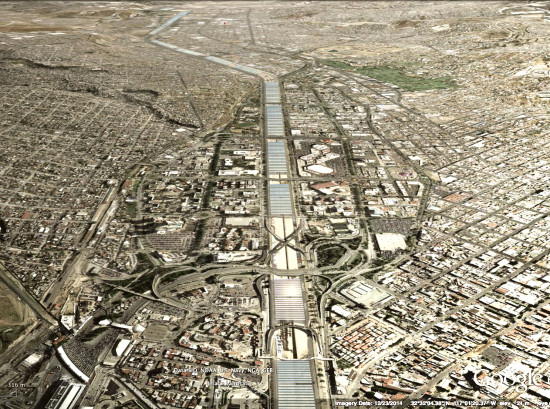
All the chatter may be around Frank Gehry and the Los Angeles River, but that waterway is not the only channelized river on the West Coast. More than 40 years ago a 10.5-mile long stretch of the Tijuana River was concretized as a flood control channel to make more development possible. If Gehry’s scheme is all about hydrology, a new proposal for the Tijuana River is about electricity.
René Peralta and Jim Bliesner’s scheme for an energy farm combines large arrays of solar panels with an algae system to remediate the water headed for the Tijuana River Estuary and the Pacific Ocean. According to Peralta, the system would produce enough megawatts to power 30,000 homes or a 112-acre industrial park.
The plan came out of a class developed as part of UC San Diego Urban Studies and Planning Program, where both men teach. Additionally Peralta directs Woodbury University’s Landscape + Urbanism Master of Science program and Bliesner leads the nonprofit Center for Urban Economics and Design.
While generating power is important, the pair see overall regional sustainability as critical goals. According to a story in the San Diego Union-Tribune, they’ve presented their work at the environmental conference Green Tijuana-San Diego Verde and have spoken to North American Development Bank.
Their preliminary analysis suggests that the solar panels could help decrease the current heat island effect impacting Tijuana’s dense urban neighborhoods by lessening solar radiation in the summer. They also proposed a partially roofed section of the river to create shade over the brutal concrete channel. Other potential infrastructural upgrades would include tree grids on top of the canal and floating algae pools that would sequester CO2 levels generated by vehicle emissions (the canal is flanked by roadways).
Although the project is in preliminary stages and still needs governmental support, it offers a much needed “hack” in the face of ecological and social costs in Mexico. Or as Peralta told Sandra Dibble of the Union-Tribune, “[Tijuana] does not have the luxury of reinventing the river to what it once was.” He noted that the solution comes from “hybridizing its old infrastructure with new technologies.” It’s about teaching an old channel some new tricks.